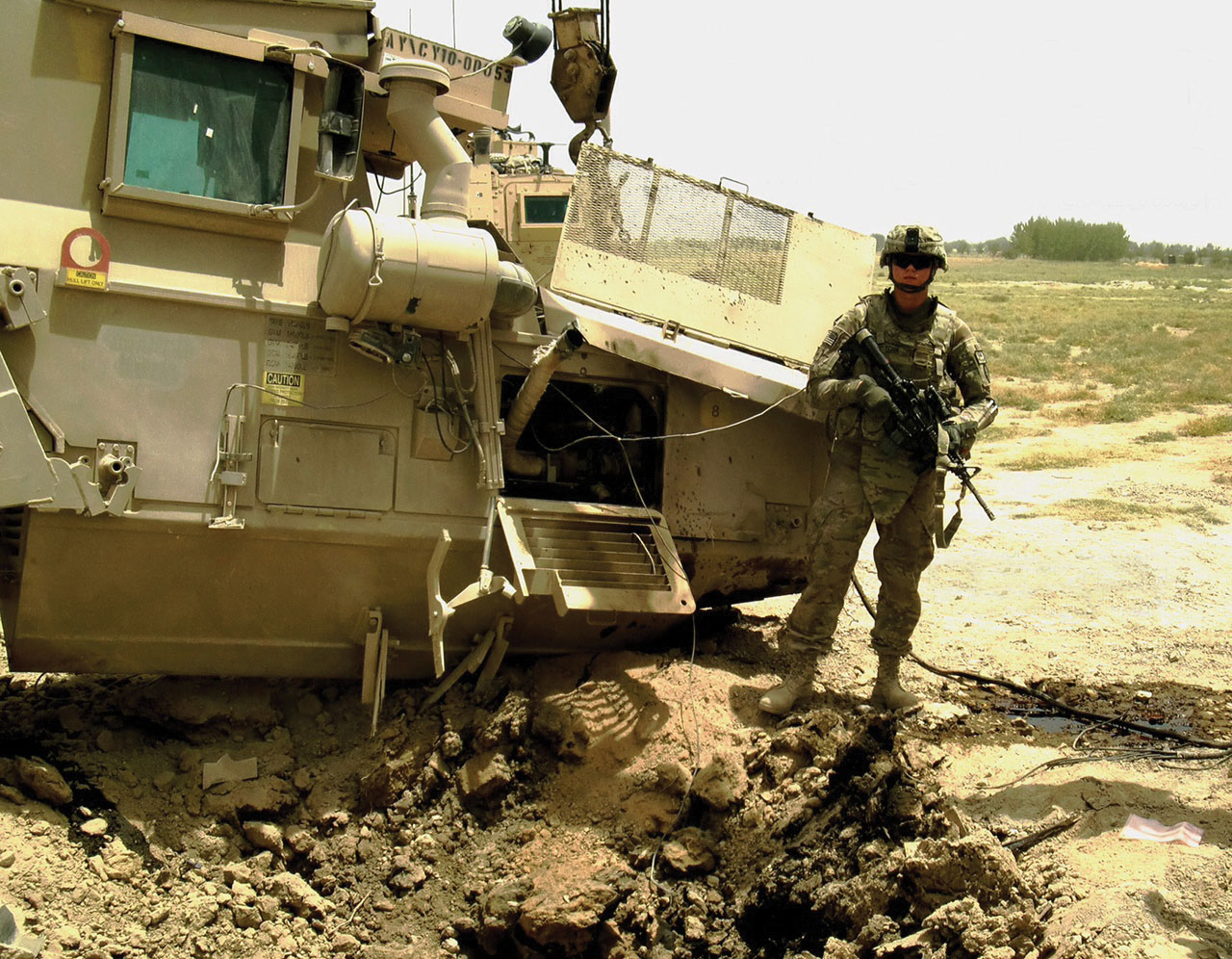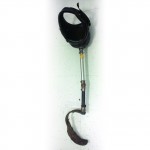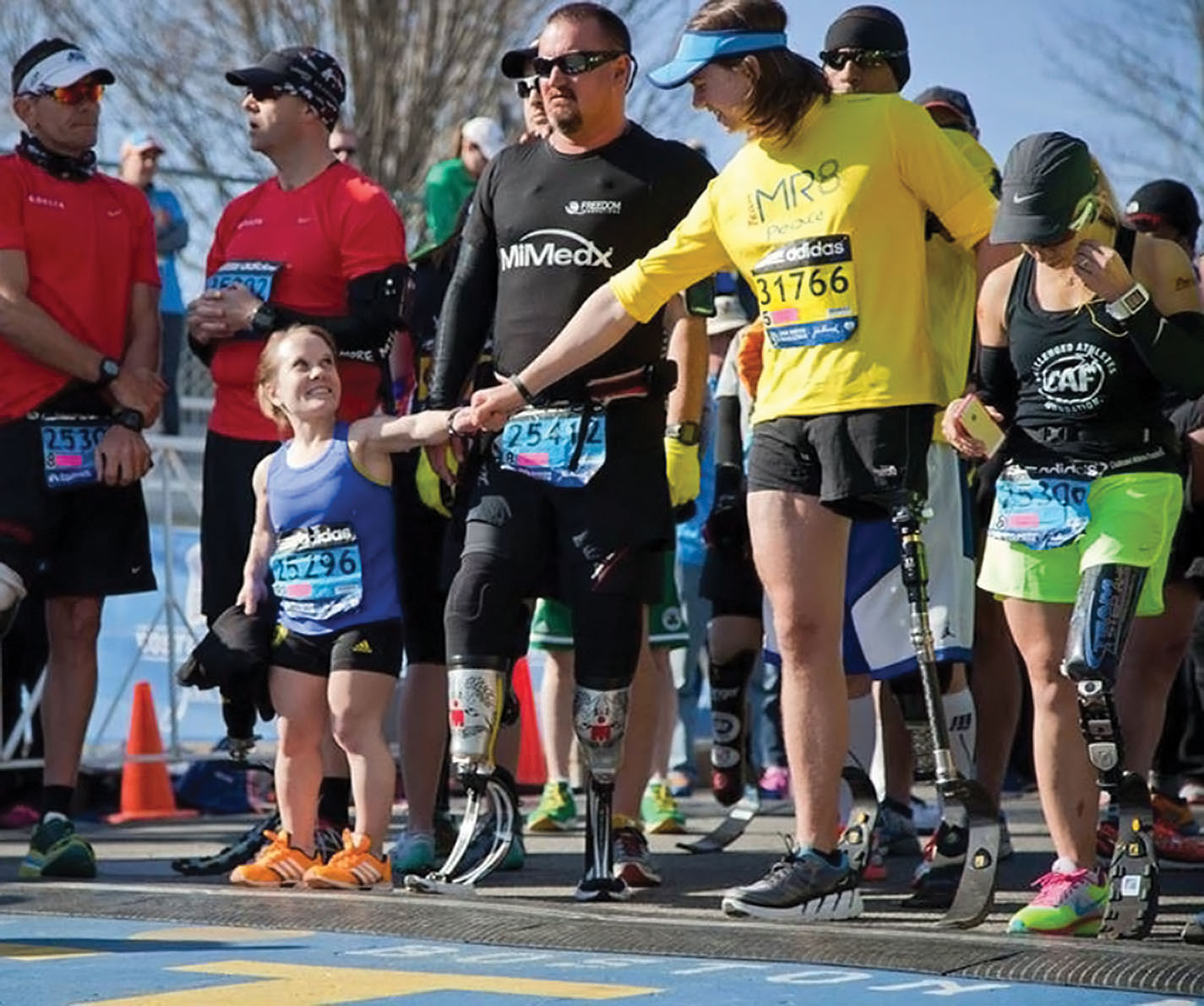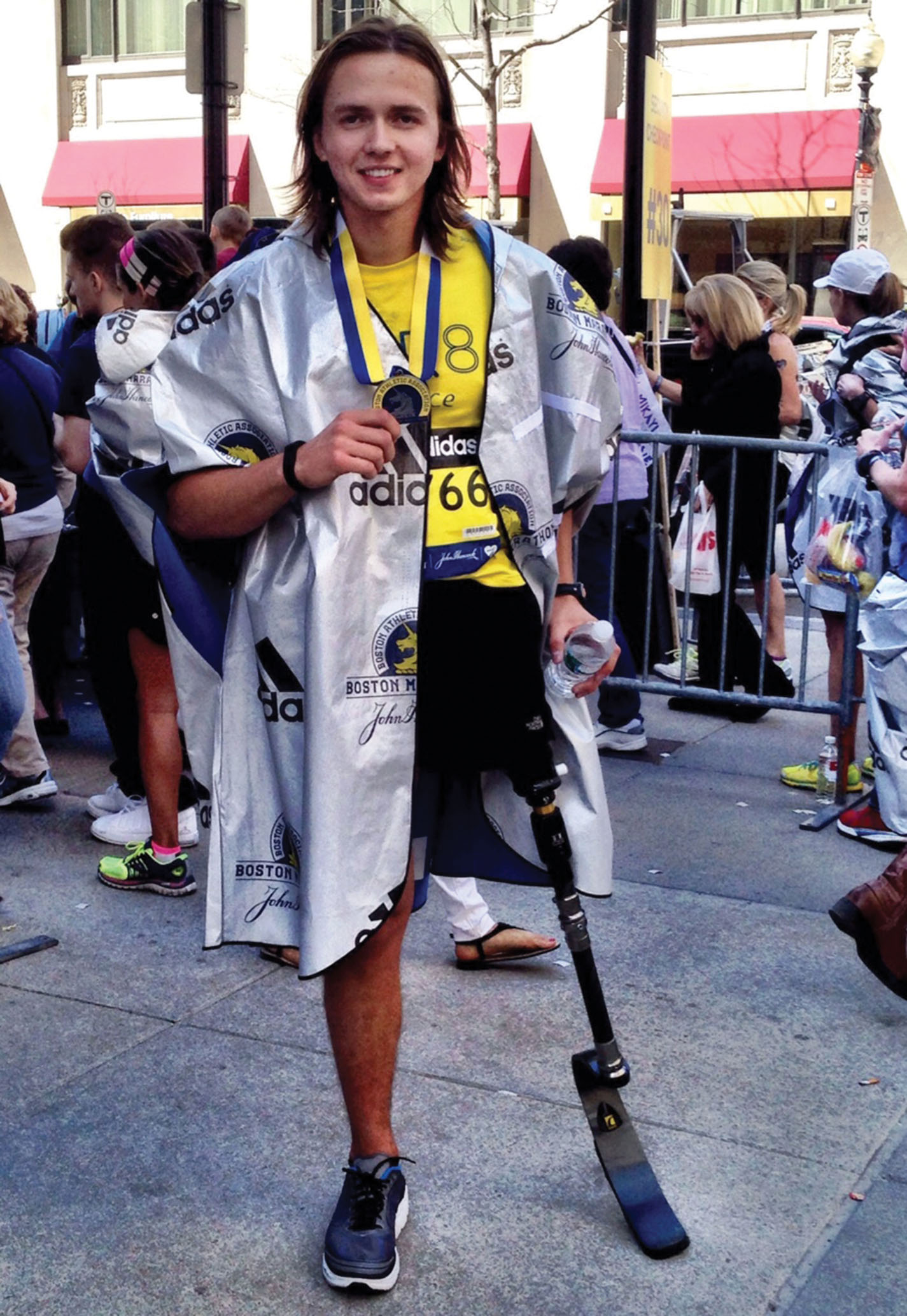
Wounded warrior develops first-of-a-kind leg prosthesis
By Mr. Steve Stark

Lychik runs in the Austin Marathon in February 2013, marking the first time a hip-disarticulation amputee had ever run a marathon. (Photo by Robert Kuenzi)
For most people, the 21st birthday is life-changing in one sense only, and a trivial one at that—they can purchase alcohol. For Edward Lychik, who turned 21 on Sept. 30, 2011, while serving as an Army combat engineer in Afghanistan, that birthday was profoundly life-changing in more ways than one.
“We always like to say the combat engineers lead the way. We’re out there in the front, leading, driving five miles an hour and looking for bombs. Once I’d find something, we’d dig it up and go blow it up somewhere else,” he said. Lychik’s job as a specialist was to drive a Husky vehicle in the front of a convoy, using sensor panels to find improvised explosive devices (IEDs). Before the injury that cost him his leg, he had been “blown up” twice by IEDs.
On his 21st birthday, he got what was supposed to be easy duty—riding in a truck in the back of a convoy. “I was safe in the rear in the gunner’s hatch, and that’s when the recoilless rifle struck me—the bazooka rocket—and blew out most of my left leg and a part of my right,” Lychik said. “I thought I knew what was going on, but I couldn’t move my body, I couldn’t feel my body, and my adrenaline was up.” He reached down to feel his leg, but someone said, “You don’t want to do that,” and pulled his hand away.

Lychik stands with one of the Husky vehicles he drove while deployed as a combat engineer to Afghanistan, about a month before his injury. Before losing his left leg, Lychik had twice been hit by an IED while driving the Husky. (Photo courtesy of Edward Lychik)
ASSESSING THE DAMAGE
When Bob Kuenzi (pronounced “Kinsey”) first met Lychik, the young Soldier was quiet and reserved. “I distinctly remember meeting him there because he was in a wheelchair, and he was wearing glasses and was kind of a skinny guy—not the kind of guy who you’d immediately think, ‘Athlete.’ ” First impressions can be deceiving.
At the time, Lychik was one of some 40 people waiting to be fitted for prostheses. It was in fall 2011, peak fighting season in Afghanistan and a very busy time at the Center for the Intrepid in San Antonio, Texas, where Kuenzi is a prosthetist. Lychik’s needs were pretty straightforward, compared to some. Although he had lost his left leg and part of his right, the rest of him was intact and relatively uninjured. Kuenzi said that when he and physical therapist Alicia White met with Lychik, “He was pretty quiet, but he was able to interact.”
As usual during the fitting process, Kuenzi went through a detailed assessment of Lychik’s strength and range of motion, the condition of his joint and skin and any highly sensitive areas, and talked to Lychik about his goals and the hobbies he had before the injury.
In Kuenzi’s experience, young men who come in for prostheses often tell him first that they want to get back on active duty, even if they’ve lost both legs and an arm. Lychik, however, “told me he wanted to run that first day.”
Kuenzi had worked with some other patients with hip disarticulation injuries like Lychik’s, in which the pelvis is still in place but the leg is completely gone, and they’d done well in demanding, on-their-feet jobs. But running?
Kuenzi did some research and found that some people with similar injuries decades earlier had been able to run a few steps, but nothing like the miles that Lychik hoped to cover. “Whereas if someone came in with a relatively uncomplicated below-the-knee amputation, I would say to them, ‘Yeah. You should be able to run,’ if only a
mile or so.”

Lychik takes in the scenery last November near his home in Tacoma, Washington. (Photo courtesy of Edward Lychik)
A VISION OF RUNNING
Some people might look at such a traumatic injury as the end of life as they knew it. Lychik came to see it as an obstacle to overcome.
He had been interested in running in middle school, but was so shy, “I was never involved in anything.” It wasn’t until he joined the Army that he really got into running. “I joined the military and there was a lot of self-discovery, I would say. Within the military, I started to grow myself internally, mentally, spiritually. And then the injury happened, and that was the biggest growth I ever had.”
After his injury, he was determined to get back to running. “I’m in the hospital bed, and I’ve got a limited mind-set, looking at the things that I can’t do. [But I thought,] I’m going to need to focus on what I can do.” From that bed, he said, he envisioned himself running. It was a full-fledged waking dream. “I was wearing this black hooded sweatshirt, and it was very foggy, and I was driven and I was focused. … Before surgery, after surgery, I would wake up and I would go to sleep, and I always had that vision.”
He also had a vision for the prosthesis that would enable him to run, but first he had to walk. “Our first mission with Ed would be to get him walking, then get him independent-walking,” Kuenzi said. “Certainly, with a hip disarticulation amputation, if somebody can be a high-functioning walker, that’s a huge success.”
Hip disarticulation is “a high-level injury,” Kuenzi said. When a patient still has some femur and thigh left, it can provide not just a place to attach the prosthesis, but also the forward motion required for walking or running. Ed Lychik didn’t have that.
For the first few months at the Center for the Intrepid, Kuenzi and White worked on getting Lychik walking. That included “a high-tech, microprocessor-controlled knee and microprocessor-controlled hip and a good walking foot. He took right to it,” Kuenzi said. “He was walking all over the hospital grounds. A lot of people would ride their chairs” for trips to lunch or elsewhere, but Lychik “was definitely going to use that prosthesis.”
But about six months into the process of trying to come up with a running prosthesis, Lychik began having problems with his walking prosthesis. His body was changing because, unbeknownst to Kuenzi, Lychik had been working out all of the muscles that he thought would be necessary for him to run successfully.
“He was telling me more and more that he wanted to run,” Kuenzi said, adding that Lychik kept asking, “‘When are we going to get this running prosthesis going?’ Another thing he said was, ‘We need to find some materials you can get wet and muddy, because I’m going to be doing that kind of thing.’
“Once we got that new socket fitted,” Kuenzi continued, “the idea was to duplicate it and then start making a running prosthesis. It really came to a point in August 2012 that we got that socket working pretty well, and Ed was getting more and more intense about it. Finally it came out that he had a ‘Tough Mudder’ that he wanted to run that was in, like, the first weekend of October.”

An early iteration of Lychik’s running leg, which he used in his first Tough Mudder. (Photo by Robert Kuenzi)
TOUGH MUD DEADLINE
For the uninitiated, a Tough Mudder is a 10- to 12-mile military-grade obstacle course based on a concept designed by the British Special Forces to test physical and mental strength. The race involves challenges such as running through a field with live wires, plunging into freezing water, climbing a half-pipe slicked with mud and grease and scaling an 8- to 12-foot wall.
Regardless of how feasible Kuenzi thought it would be, the race provided a deadline for the team to finish the running prosthesis. Lychik loved working with Kuenzi. “There’s a lot of people who only stick to what they know. They don’t like to go outside the box,” he said. Not so Kuenzi, who is himself an amputee, having lost part of a leg in a motorcycle accident when he was 19, which was why he became a prosthetist. Lychik had a table in Kuenzi’s office with parts and tools. “I had a lot of demands on myself and on him,” Lychik said. “We would stay late hours. If something didn’t work, we’d try different parts. It must’ve been exhausting for him.”
Theirs wasn’t just a professional relationship, Lychik said. “It was like I was working with a friend, too. I could talk to him and tell him how I was feeling, it wasn’t like there was anything I couldn’t say. … And once you can connect with someone, you can combine a few like-minded people and create something really amazing. A lot of times I get the credit for doing this, but without people like Bob and Alicia—there’s a whole mountain of people who were there to support me. It was a team effort.”
The first iteration of the new prosthesis, like the walking leg, had a hip and knee joint. With the prosthesis in place, Kuenzi and White hooked Lychik up in a harness that runs along a track of about 40 feet, part of the training apparatus for people learning to use leg prostheses. “He was able to do some running on that, but it was pretty obvious that that setup wasn’t going to work because it was too unstable” with the articulation of the knee and hip, Kuenzi said. “First we took the knee out and just made it a straight leg, and then eventually took the hip joint out, too, and bolted the pylon to the socket. That really looked kind of like a pogo stick, and functioned like one, too.”
It resulted in a gait that was almost stride-bounce-stride. “He’d have to swing it out to the side to clear the ground. And all this time he’s having to use his core muscles, his abdomen and his upper body to stabilize his trunk and move it, do a pelvic tilt every step.”

Lychik fist-bumps Juli Windsor at the start of the 2014 Boston Marathon on April 20. (Photo by Taylor Paige)
AMAZING PROGRESS
That’s why Lychik had been lifting weights. “What really amazed me about his progress was that within a week of getting this leg, he ran a mile in, like, nine minutes. To me, that’s unheard of. I asked him, and he said he’d been doing super sets—he’d trained himself with power-lifting strategies with his good leg, his torso and his arms. … There was nobody here who was pushing him. He totally did it on his own, and he was ready.” As far as anyone knows, Lychik is the first ever to run that kind of distance with his particular injury.
A few weeks later, when they were on the third or fourth version of the prosthesis, Lychik ran the Tough Mudder in the Texas hill country outside Austin. He was on a team with the Wounded Warrior Project, several of whom were amputees, and they helped one another over the obstacles, Kuenzi said.
The prosthetist drove out to see Lychik run in the 12-miler and took some tools with him in case the prosthesis needed tweaking. “It was very inspiring to watch, because I would have thought he would have run a couple miles, maybe, and I kept expecting to see one of those golf carts come up with him in it. He disappeared for a while and I went over to another area, and when he came by, he was loping along, carrying the flag. He was jazzed. … He finished it.”
In April 2014, Lychik, now medically retired from the Army, competed in the Boston Marathon, finishing the race in 4:44:25. The News Tribune of Tacoma, Washington, reported that Lychik ran with a team associated with the Martin W. Richard Charitable Foundation, formed to honor the 8-year-old boy killed in the 2013 marathon bombing. “I was running it for him,” the newspaper quoted Lychik saying. “He doesn’t have the opportunity, so I got to do it for him.” On May 4, he finished the Tacoma City Marathon.
Read more here: http://www.thenewstribune.com/2014/04/21/3159570/boston-crowds-roar-for-tacoma.html#storylink=cpy

Lychik, shown after finishing the Boston Marathon in April, is the first known hip-disarticulation amputee to run in the event, and did so on a prosthetic leg he helped create. (Photo courtesy of Edward Lychik)
COMMUNICATING SUCCESS
Shortly before the marathon, Lychik spoke with a group of middle-school kids in the Tacoma area. He wants to spread a message of positive thinking and is working on what he calls “my speech.”
“The only person who can ever stop you is you. We put the limitations on ourselves. Right when I started to run, running 400 yards, a mile, two miles and then running another event, [I started to wonder], what else am I capable of doing? I wasn’t just going out and doing all of these events for myself. I wanted to show people that if somebody with one leg, a hip amputee, can go out and do this, what could a person with two good legs be capable of? Not just running. What are they capable of if they really set their heart and mind to it and persevere?”
During the months Lychik was in rehab at the Center for the Intrepid, Kuenzi said he saw the Soldier grow tremendously. That happens to a lot of the guys who come through the center, he said. “When they come in, they’re just a lump,” having been through a tremendous amount of stress from their injuries and recovery. And by the time they leave, “You can see the change. They’ve got motivation, they’re going to go to school. They’re going to do something with their lives.”
A year and a half after his life-changing injury, when Lychik was about to leave the military, he said, “I set out for a run in the evening, and I was wearing a black hooded sweatshirt and it was very foggy. I was determined, and I knew where I was going with my life. At that moment, I stopped, I had tears in my eyes. I realized that this was me living what I once saw, envisioned in the hospital, when I was trying to reach out for the impossible.”
For more information, see Edward Lychik’s blog at edwardlychik.wordpress.com or on Facebook at https://www.facebook.com/edwardlychik. For more information on the first-of-its-kind leg, contact Robert Kuenzi at robert.s.kuenzi.ctr@mail.mil or 210-916-7740.
MR. STEVE STARK provides contracting support to the U.S. Army Acquisition Support Center for SAIC. He holds an M.A. in creative writing from Hollins University and a B.A. in English from George Mason University. He has worked in a variety of positions supporting communications for the Army and Navy, and has written about defense-related topics for more than a decade. He was the founding editor of the Program Executive Office Soldier Portfolio and edited the Army’s Weapon Systems handbook for six years.
This article was originally published in the July – September 2014 issue of Army AL&T magazine.
Subscribe to Access AL&T is the premier online news source for the Acquisition, Logistics, and Technology (AL&T) Workforce.![]() Subscribe
Subscribe







